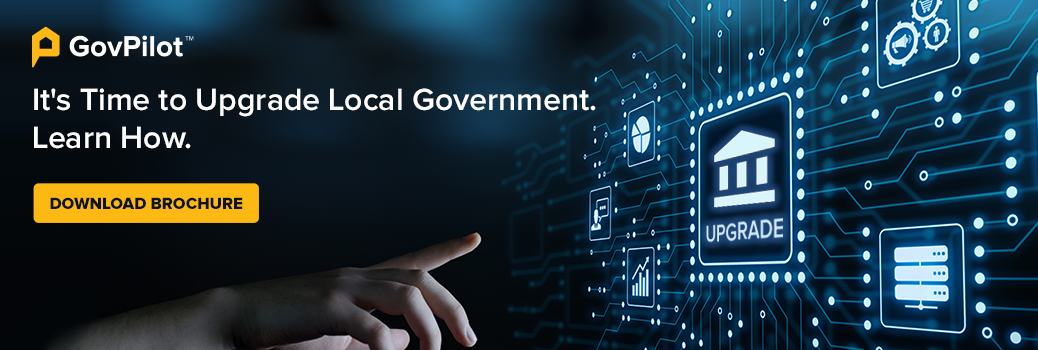While you might think you’re playing it safe by sticking with decades old processes, the truth is it’s costing your locality substantial time and money.
GovTech Magazine's recent opinion piece highlighting the critical importance of local governments recognizing their innovation debt is chock full of important takeaways, including this key revelation: sticking with that status quo and doing the bare minimum to embrace modern government technology will have negative consequences on the efficiency and cost of your government processes.
In this article, we’ll define innovation debt before highlighting the aspects of your local government you should prioritize modernizing to reap major benefits.
What is Innovation Debt? Why Does It Matter for Local Government?
Innovation debt in local government can be defined as the costly expenditures that result from failure to innovate. Antiquated processes like paper-based workflows, in-person work requirements, and storing data with physical servers pose serious consequences when it comes to efficiency, budgeting, employee recruitment and retention, cyber security, and virtually every aspect of your local government.
Fortunately, many local governments have already taken strides to advance their workflows and are reducing their innovation debt every month by embracing modernity. If your local government has just scratched the surface with government technology (or hasn’t adopted govtech at all) you’ll need to seriously consider software that can automate every government department in your locality and begin onboarding government workers as soon as possible.

Areas of Local Government Most Implicated by Innovation Debt
Modern technology can advance practically any aspect of your local government. Here are some of the areas you’ll especially need to consider embracing government tech for improving efficiency and mitigating risk:
1. Information Technology (IT)
A key component of a local government information technology strategy is embracing modern technology that will benefit your public institutions. That’s because:
- risks like government data breaches and natural disasters pose the potential permanent loss of government data if you’re still using physical data servers
- Efficient IT ticketing processes are becoming increasingly essential as processes like permit filing, document requests, and internal government communications are moved online across government departments
- Key constituent services and government processes are reliant on smooth running government systems.
Here’s how you can reduce your innovation debt for the IT department:
- Leverage cloud-based IT ticketing software to streamline ticket requests and automate the assigning of tasks to IT officials
- Update antiquated computer systems and infrastructure with modern computer systems and broadband technology.
- Expect IT officials to embrace modernity and regularly follow technical trends, both from a general perspective as well as government tech advancements.
2. Filing of Applications and Document Requests
Regardless of your government department, a lot of your processes come down to filling out paperwork (or helping constituents to do so) and filing it. With government software’s ability to automate administrative workflows via robotic process automation (RPA), every month you delay embracing government technology is a costly expenditure in staff hours inefficiently spent managing paperwork.
Here’s how you can reduce your innovation debt in application and document request processes:
Licensing and permit applications being made available from your government website make it easy for constituents to submit applications. That’s more convenient for your community-members and saves government workers time previously spent supporting customers facing difficulties in filing in-person or over the phone.
Document requests have also never been easier. No longer do constituents need to drive to their courthouse to pick-up court records, as it’s all readily accessible online via the cloud.
Learn more about how these processes work government-wide in our guide to Government Software Solutions Across Departments.
3. Modernizing Physical & Digital Infrastructure
American infrastructure was once considered the best in the world. Unfortunately, physical infrastructure has been decaying for decades and will continue to do so unless addressed by your locality.
There’s serious innovation debt for local governments that comes with slow-moving bureaucracy. Impeding physical and digital infrastructure projects from being completed in a timely and cost-efficient manner is bad for everyone involved.
Here’s how you can reduce your innovation debt in infrastructure maintenance processes:
Thankfully, there’s bipartisan public support in spending tax dollars and federal legislation to modernize antiquated infrastructure when it comes to roads, bridges, parks, and other public institutions as well as digital infrastructure. And as federal and state governments take on the effort to move local governments into modernity, laws like the Infrastructure Investments and Jobs Act are putting dollars into local governments to be spent on essential infrastructure needs in their community.
Both the Infrastructure Bill and the American Rescue Plan Act grant funds can be used towards physical and digital infrastructure. Consider which infrastructure issues pose the biggest risk and inconvenience to your constituents, and be sure to embrace modern digital infrastructure to make processes like business registration, construction permits, building inspections, and RFPs as efficient as possible.
4. User Experience (UX) of Your Government Website
Let’s face it: most local government websites aren’t known for being stylish and intuitive. Yet your constituents are completely depending on it for finding out critical information and accessing forms and documents.
While your local government site is ideally meeting ADA compliance, if you haven’t worked with developers to design a sleek and easy-to-navigate website, you're doing your constituents a disservice.
Here’s how you can reduce your innovation debt in government website UX:
Look how easy it is to find the relevant application and file it with GovPilot’s modules on the Atlantic City website. Use relevant budgeting to improve on your government website in a way that makes it easy for constituents and government officials to track down what they’re looking for in just a few clicks.
How did Atlantic City upgrade their local government? Here’s a case study about Atlantic City’s Successful City-Wide Digital Transformation with GovPilot.
5. Fee & Fine Processing
If you’re procrastinating on modernizing your government payment collection processes, you’re losing out on serious revenue generation as a result of code enforcement penalties and application fees. GovPilot’s modern government software offers simplified integrations with over 9 of the top and most secure payment processing platforms in the United States.
Here’s how you can reduce your innovation debt in fee and fine processing:
When issuing fines and collecting fees, don’t stick to the status quo and make constituents pay in-person or by mail. Doing so will result in a drop in completed fine payments and a reduction in completed applications that generate revenue via government service fees.
Allow constituents to pay fees, fine, and recurring monthly payments to your locality online 24/7, 365 with modern gov tech.
6. Means of Local Transportation
Like any other infrastructure, weak public transportation and limited walkability plagues communities across the United States. Roads with high-speed automotive traffic paired with foot traffic (known as stroads) pose a risk to constituent safety and are inefficient for both drivers and pedestrians. A lack of accessibility to local businesses by foot or bicycle has a negative impact on the local quality of life and economic development. A lack of public spaces like parks or walk-only streets has a direct impact on local property values and tourism.
These are just some of the many debts your locality and its constituents will pay the price for if you don’t modernize your community’s zoning and transportation policies.
Here’s how you can reduce your innovation debt in public transportation:
The data is clear: urban transformation that makes it easy to walk or bike around your city in 15 minutes or less is a great way to increase constituent health and happiness while also encouraging population and economic growth.
Consider using your federal grant funds meant to be allocated towards public infrastructure for increasing accessibility around your community without a car, and give serious consideration to innovating in the zoning department with technology like 3D GIS mapping.
Looking for some urban transformation inspiration? Explore the guides to 15-Minute Cities and Improving Pedestrian Zones and Bike Lanes in Your Community.
How Can Your Local Government Reduce Its Innovation Debt Without a Temporary Decline in Productivity?
Many local governments have been increasing their innovation debt because their government workers are accustomed to things working a certain way and want to keep it that way.
Fortunately, adopting government technology isn’t as scary as it might seem. GovPilot partners across states, community-types, and government departments reported feeling comfortable with the government operating system in just a few days.
GovPilot has onboarding specialists and years of experience helping local governments to embrace digital transformation to make your transition process smooth and your government worker’s questions and concerns heard and addressed.
Wondering How to Embrace Private-Sector Partners As a Local Government? Here’s what to know.
Reducing Your Local Government Innovation Debt
Your locality has hopefully taken steps in the right direction to becoming an innovative local government in recent years with advancements in technology and acceptance of modernization in local government.
But to truly reap the benefits of modernity, your local government needs to embrace going fully digital across government departments to reduce your innovation debt. Doing so will result in more money, better efficiency, and a happier quality of life for your constituents and government workers. What are you waiting for?
To learn about the GovPilot operating system for local governments, book a free demo.
FAQs
What is Innovation Debt?
Innovation debt is when an organization (like a government or businesses) experiences an uptick in costs and inefficiency as a result of not embracing more modern technology. For local governments in general, a reliance on antiquated, paper-based workflows has resulted in seriously costly and slow-moving workflows for decades. This has resulted in millions of tax dollars spent unnecessarily and thousands of man hours at even the local level since technology could’ve been used to automate tasks and speed up project timelines.
How Does Technology Save Governments Time & Money?
Government technology will automate mindless administrative tasks, automatically assign relevant projects to the right government officials, and make organizing paperwork simple with cloud-based infrastructure. Along with the savings in man hours, government software also pulls data into real-time dashboards, allowing you to make sharper financial decisions and make other data-backed decisions.
Read on:
- Local Government Accountability: Operating a Truly Ethical Local Government
- Local Government Automation: Benefits of Going Digital
- How Do Online Permitting Systems Work?
- Government Data Breach Prevention: Preventing Data Loss & Leaks
- What is GovTech? Everything to Know About Government Technology
- Modern Government Trends, Events, & Technology
- Tornado Mitigation & Disaster Plan
- Wildfire Mitigation & Disaster Plan
- Local Government Disaster Preparedness Guide
- Continuity of Government: Government Procedures During a Crisis
- Best Software for Government Procurement
- How to Build a 15-Minute City
- Building Inspections 101: How Municipalities Can Improve Public Safety
- Government Cybersecurity: How to Prevent Ransomware Attacks
- Municipal Planning: Reclaiming Your City Streets
- Government Blockchain: How Local Government Can Use Crypto
- How Local Governments Can Encourage Civic Engagement
Sources:
https://www.govtech.com/opinion/what-is-innovation-debt
https://www.fastcompany.com/3008134/your-company-going-innovation-debt

-2.png)





